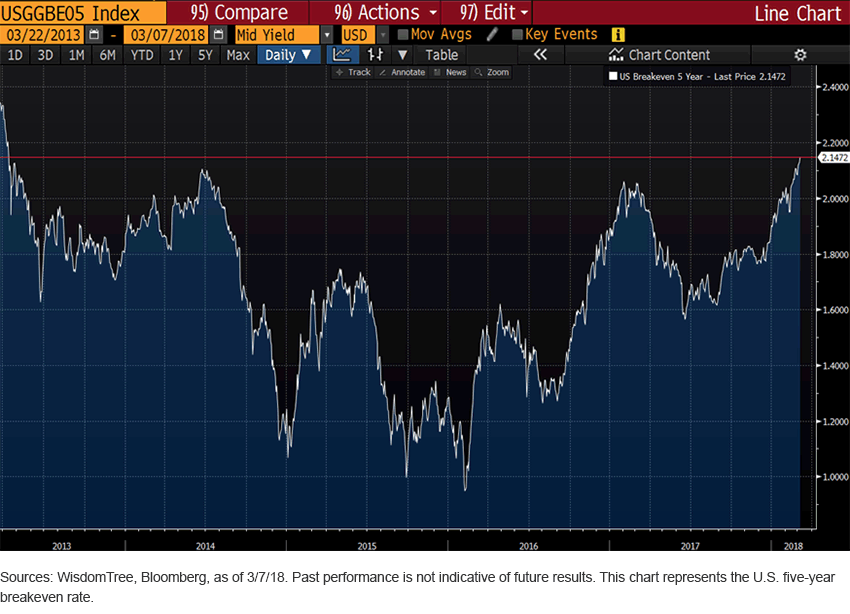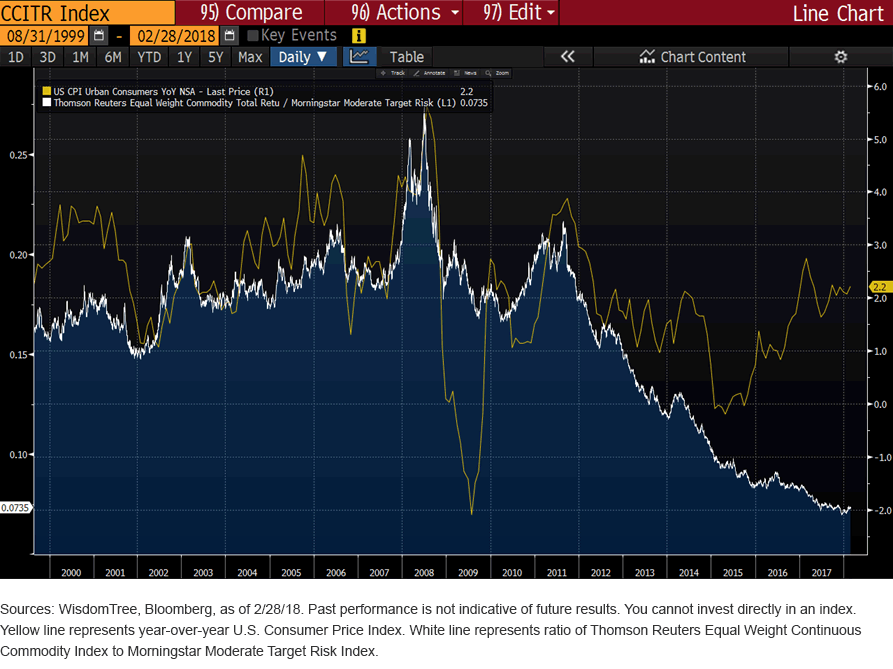Why It May Finally Be Time to Add Commodities to Your Portfolio


Something strange started happening at the beginning of 2018. For the first time in a long time, investors started asking us what we thought about commodities.
For the past several years, any time we talked about commodities, it felt like we were banging our heads against a wall. Investors were disinterested, and who could blame them? The performance of the asset class was nothing short of awful. To quote my colleague Jeff Weniger, commodities became the star of his “stinker study” starting back in 2013—and then they somehow performed even worse from there.
That said, we now have a few reasons to finally be positive on the asset class. As Jeff mentioned, commodities are a prime candidate for mean reversion, given a decade of disappointing performance. Continued weakness in the dollar has provided a tailwind for prices. From a demand perspective, China’s Belt and Road initiative may act as a boon as the total expenditure of the project could reach as much as $8 trillion by some estimates. President Trump has continued to float an infrastructure bill to improve the country’s aging bridges, tunnels and roads, which would be a particularly welcome addition for those of us in the Northeast.
Structurally speaking, contango in the futures curve of many commodities led to severely negative roll yields for a few years, but that has recently improved for several contracts. Additionally, as the Federal Reserve (Fed) continues along its rate hike trajectory, the collateral returns of commodities futures contracts have ticked up as well.
Inflation: The Elephant in the Room
But when making the case for commodities, the biggest determining factor almost always comes back to inflation. It’s no coincidence that several years of commodity underperformance occurred at the same time when inflation remained stubbornly low in the U.S. With the potential for faster economic growth and with increased Treasury supply that could help moves rates higher, the possibility of inflation coming back has risen. In fact, the five-year breakeven rate, the market’s measure of expected inflation, in early March hit the highest level in five years.

The most obvious connection between the two is that commodities are commonly viewed as a natural hedge for inflation—and that inflation is often driven by rising commodity prices. However, when viewing inflation from the context of an investor portfolio, we think commodities make sense for two additional reasons.
Time to Rethink the 60/40
With the coordinated sell-off in the first quarter of 2018 in both stocks and bonds, the correlation between the two asset classes moved upward at the worst possible time for investors. For the last several years, investors could be sure that in the rare occasions when their stocks were down in value, their bond portfolios were likely helping buffer from losses—but not this time. If the two asset classes can no longer be counted on to move in opposite directions, the typical 60/40 portfolio may be more vulnerable than normal.
UBS recently published a research paper that digs into the historical correlation between stocks and bonds. In the report, the authors state that the correlation was most influenced by two data points: the level and volatility of inflation.1 During times with high inflation or more volatile inflation prints, the correlation between the asset classes rose. In other words, when inflation goes up, the diversification benefits between stocks and bonds go down.
From a portfolio perspective, this can have huge ramifications. Should we be reentering an inflationary environment, investors need to be aware that their traditional asset allocation framework may not work as they expect it to. With a potentially positive correlation between stocks and bonds, it may make sense for investors to look to alternative asset classes for their portfolios—with commodities seemingly a natural fit.
Not Just a Hedge, an Outperformer
The second reason is because when inflation moves upward, these periods historically have been the precise times when commodities not only maintain their value, it also marks when they outperform the traditional 60/40 portfolio.
The Thomson Reuters Equal Weight Continuous Commodity Index was incepted in August 1999. Dating back to its inception, there historically has been a strong correlation between the U.S. Consumer Price Index and the relative performance of the commodity index compared with a moderate investor model.

Admittedly, the linkage appears to have moved apart since September 2015 (largely due to U.S. equities continuing their remarkable post-crisis run, as over this time, the S&P 500 has risen 48%, with its price-to-earnings ratio expanding from 17x to 23x earnings2). Whether this represents a permanent break or a temporary breather from a 15-year trend may soon be determined.
More Than Just Oil
When analyzing potential vehicles in which to invest, we’ve found that some of the largest commodity mutual funds and exchange-traded funds (EFTs) are concentrated in contracts related to energy and oil. While the price of a barrel of oil is undoubtedly important, just as with all other asset classes, we think diversification is key.
The WisdomTree Continuous Commodity Index Fund (GCC), which tracks the Thomson Reuters index, equally weights 17 different commodities contracts and rebalances daily. This ensures no individual contract or sector can dominate the underlying exposure of the ETF, and that its return drivers will have more determinants than just the price of oil.
With investors finally reconsidering adding commodities to their portfolios once again, we think a strategy like GCC can be a very useful diversification tool—especially if the inflation that the market is anticipating finally arrives.
1“Relationship Troubles,” UBS Asset Management, February 2018
2Sources: WisdomTree, Bloomberg, FactSet. From 9/30/2015 through 2/28/2018Important Risks Related to this Article
There are risks associated with investing including possible loss of principal. An investment in this Fund is speculative, involves a substantial degree of risk, and should not constitute an investor’s entire portfolio. One of the risks associated with the Fund is the complexity of the different factors that contribute to the Fund’s performance. These factors include use of commodity futures contracts. Derivatives can be volatile and may be less liquid than other securities and more sensitive to the effects of varied economic conditions. The value of the shares of the Fund relate directly to the value of the futures contracts and other assets held by the Fund, and any fluctuation in the value of these assets could adversely affect an investment in the Fund’s shares. The Fund is not an Investment Company within the meaning of the Investment Company Act of 1940, as amended, and is not subject to the regulations thereunder. Please read the Fund’s prospectus for specific details regarding the Fund’s risk profile.
Investments in commodities may be affected by overall market movements, changes in interest rates and other factors such as weather, disease, embargoes and international economic and political developments.
Commodities and futures are generally volatile and are not suitable for all investors.
Diversification does not eliminate the risk of experiencing investment losses.


